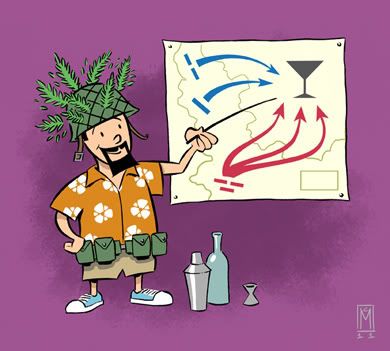Monday, June 6, 2011
Tales of the Cocktail: Preemptive Strike (Part 3)
Next up in this series of pre-Tales dispatches is a brief Q &A with Wayne Curtis. Wayne is a freelance journalist who has written for many fine periodicals including The New York Times, Saveur, The Atlantic and Travel+Leisure. However, booze geeks likely know him best as the author of And a Bottle of Rum: A History of the World in Ten Cocktails.
This year Wayne will be heading up the presentation "Beyond Punch: Colonial American Drinks and How to Mix Them", and he graciously let me pepper him with questions concerning this period in American drinking.
You wrote in And a Bottle of Rum that rum played a big part in the drinking scene during the early days of the US. What were some of the other things people were drinking at that time?
Mostly cider, lots of beer, and whiskey was starting to come in, but it remained hampered by transportation issues (no trains or canals from beyond the Appalachians until nearly the mid-19th century). Rum was cheap and easy to find in port cities since there was lots of trade between the 26 British colonies (of which 13 elected to break off and declare independence.)
Could you briefly describe the role alcohol played in the day-to-day life of the average person in colonial America? For example, was it common to consume alcohol with every meal? Was it mainly consumed recreationally and socially?
Beverage alcohol was medicine, provider of comfort, salve, healer of all ills including chilblains. You had some in the morning to start your day properly, then you had some more spirit when you took a lunch break, and there was no better way to cement the bonds of friendship and catch up on the news than having a slug of rum or cider at night at the tavern.
What is an example of a popular alcoholic beverage that could be found in a pub/tavern during this time period?
Punch, of course -- taverns almost always had punch bowls and ladles and cups. But tavern owners were creative and mixed up what they had to create potions that would distinguish them from their competition. Shrubs were popular -- this was a way of preserving berries or stone fruits into the winter by soaking them in vinegar. Pour out a little of that, add sugar, some rum, and you could turn a dark February evening into a taste of summer. Which was sort of a remarkable thing in an era before refrigeration and air-express shipping.
How much distilling was done at home vs. commercially?
Home distilling was far more common then than now -- because if you lived on an isolated farm, you had to make most everything you needed. So small stovetop contraptions would provide a bit. And rural folks knew other tricks, like leaving a pail of hard cider out in the barn during the winter, and then scraping off and discarding the ice periodically, which would increase the proof and result in a sort of crude applejack. (Water freezes before alcohol.) In the cities, with the proliferation of taverns and distillers, there was less home-distillation. Remember that in New England alone, there were something like 160 commercial rum distilleries cranking out product on the eve of the American Revolution. You didn't have to go far to find a tot of rum, especially in the seaboard cities.
Were the drinking habits of the wealthy markedly different from the poor?
Everybody drank, and heartily, but the rich drank better, of course. They could afford imported Madeira and port to mix in their punches. And they would drink rums from the West Indies, which most contemporary accounts suggest tasted far better than the rums made in New England.
What types of drinking vessels were the most commonly used (glass, metal, earthenware, etc.) and what drinks were traditionally served in them?
Glass was favored by the upper crust -- elegant punch glasses and the like were more expensive to obtain, and when you had them you took good care of them. Otherwise, it was whatever you had on hand -- be it pewter mugs or crude earthenware or more refined ceramic tankards, or sipping out of the ladle. You'd find a real mix of vessels around the colony, with the poorer imbibers obviously using the cheaper earthenware.
Were there any drink ingredients or preparations being used at that time that we would find surprising today?
Flip is most surprising -- it was made by mixing up rum, beer, and a sweetener like molasses in a pitcher, then stirring it with a piece of iron that had been heated to red-hot in a fireplace. The mess would foam up and sputter, and the end product had a distinctive taste... strangely, a bit like Starbucks coffee, from all the grains in the beer being burned.
"Beyond Punch: Colonial American Drinks and How to Mix Them" happens from 10:00 to 11:30 am July 21 in the Queen Anne Ballroom at the Hotel Monteleone. Go here to purchase tickets.
Subscribe to:
Post Comments (Atom)



1 comments:
Oh man... see what you are doing?
I haven’t booked my sessions yet, and by the way things are going you are not going to leave me any to buy…
Wayne´s talks are always a great choice!
Post a Comment